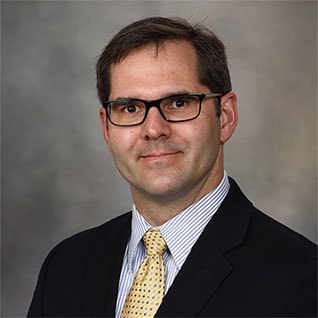From the program director
 Thank you for taking the time to research the therapeutic medical physics residency program here in Rochester, Minnesota.
Thank you for taking the time to research the therapeutic medical physics residency program here in Rochester, Minnesota.
Residents are trained on cutting-edge equipment in a busy practice with a wide variety of procedures. A physics faculty-to-resident ratio of over 3-to-1 means that residents have ample one-on-one training with ABR-certified physicists.
Our residency program is structured a bit differently than most: instead of just two years of clinical training, we incorporate an extra year that allows residents to spend approximately one-third of their residency in clinically focused medical physics research.
Having both three-year and two-year programs in the past, we find this three-year format better prepares our residents for the mixed responsibilities of junior medical physics faculty. The structure allows a resident’s clinical training experience and research experience to inform and complement one another, allowing our residents to enhance their training and develop lasting improvements in the quality of patient care.
Minnesota Community has more information about Rochester, Minnesota, and the surrounding area. I expect you might be surprised by what the area has to offer.
On a more personal note, I was a resident in this program myself before joining our physics faculty and eventually becoming the program director. I can still remember the sense of wonder I experienced in my first visit to the Mayo Clinic campus, and my words hardly do justice to the dedication the people of Mayo Clinic. As you explore our website, please do not hesitate to reach out to Elaine Eckheart or myself if you have any questions.
Sincerely,
Nicholas Remmes, Ph.D.
Program Director, Assistant Professor of Medical Physics
/prod01/channel_2/media/mccms/content-assets/academics/residencies-and-fellowships/radiation-oncology-clinical-medical-physics-res-mn/Remmes_Nicholas_B_512X512.jpg)
/prod01/channel_2/media/mccms/content-assets/academics/residencies-and-fellowships/radiation-oncology-clinical-medical-physics-res-mn/department-and-faculty/image-1024X512-WF1691940_3968937_0034.jpg)
 Thank you for taking the time to research the therapeutic medical physics residency program here in Rochester, Minnesota.
Thank you for taking the time to research the therapeutic medical physics residency program here in Rochester, Minnesota./prod01/channel_2/media/mccms/content-assets/academics/residencies-and-fellowships/radiation-oncology-clinical-medical-physics-res-mn/department-and-faculty/john-lucido-512X512-16268636-20250602.png)
/prod01/channel_2/media/mccms/content-assets/academics/residencies-and-fellowships/radiation-oncology-clinical-medical-physics-res-mn/department-and-faculty/debra-brinkman-512X512-202507032134.png)
/prod01/channel_2/media/mccms/content-assets/academics/residencies-and-fellowships/radiation-oncology-clinical-medical-physics-res-mn/amanda-deisher-phd.jpg)
/prod01/channel_2/media/mccms/content-assets/academics/residencies-and-fellowships/radiation-oncology-clinical-medical-physics-res-mn/luis-fong-de-los-santos-phd.jpg)
/prod01/channel_2/media/mccms/content-assets/academics/residencies-and-fellowships/radiation-oncology-clinical-medical-physics-res-mn/department-and-faculty/Antolak-John-512X512-WF14472902_20240729.jpg)